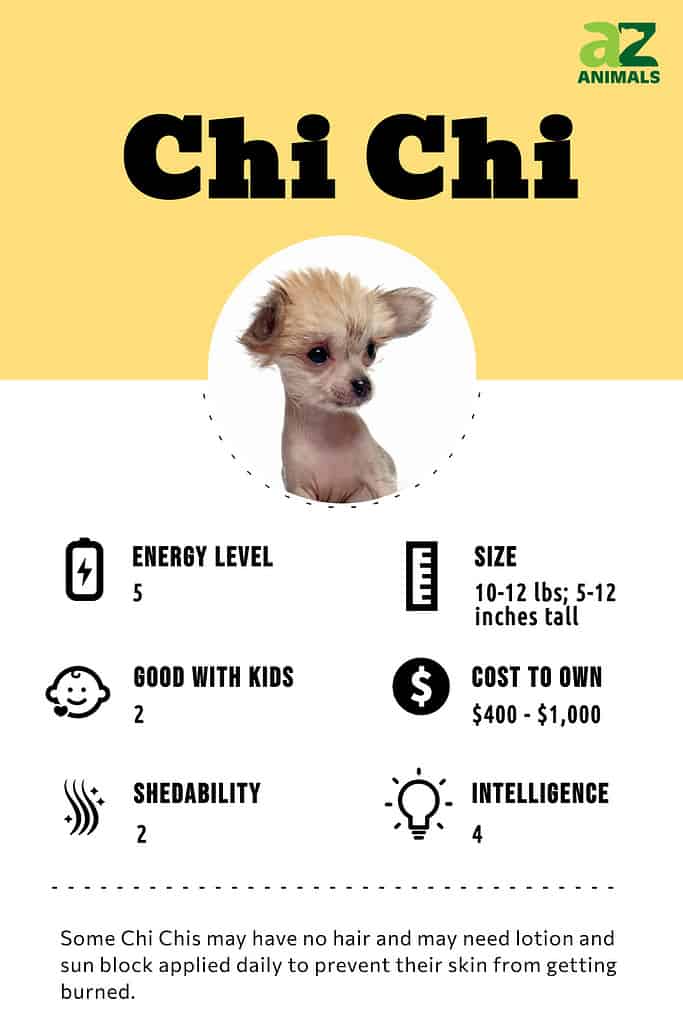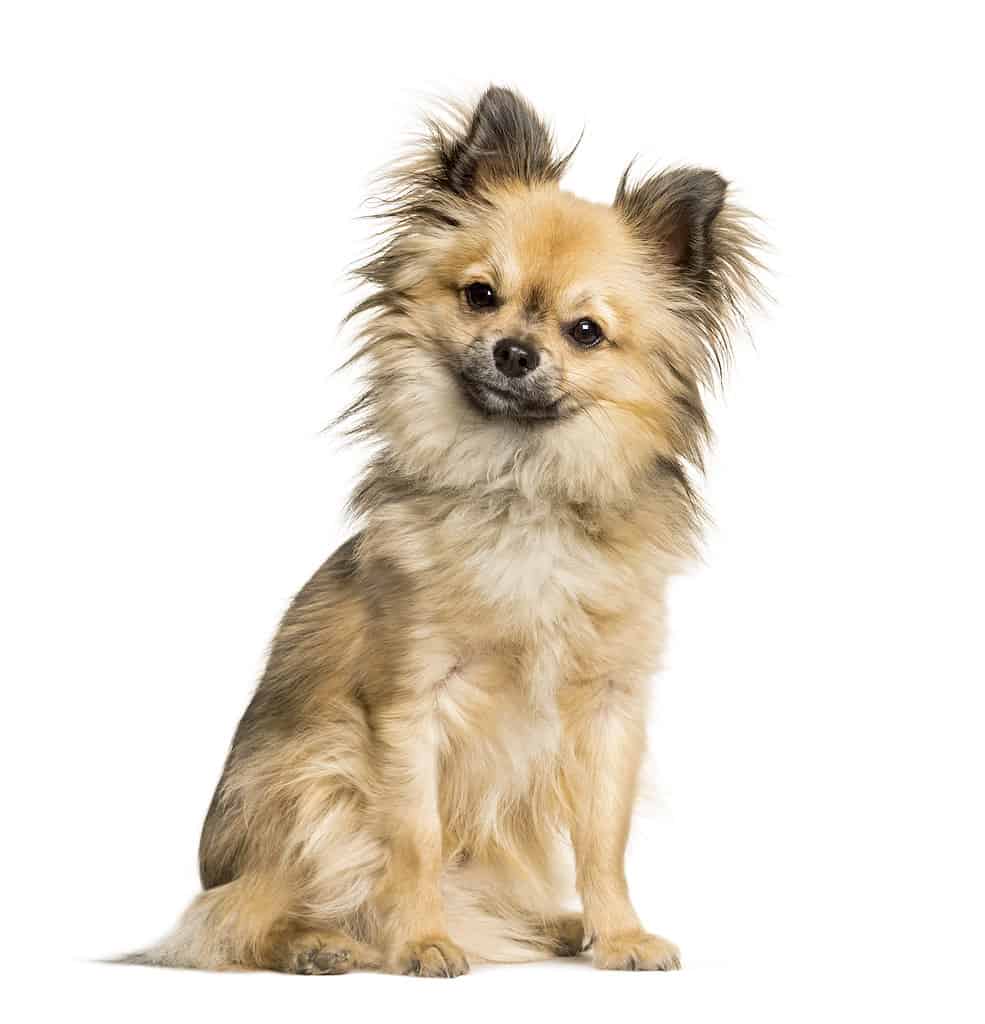Chi Chi
Canis lupus
Advertisement
Chi Chi Scientific Classification
- Kingdom
- Animalia
- Phylum
- Chordata
- Class
- Mammalia
- Order
- Carnivora
- Family
- Canidae
- Genus
- Canis
- Scientific Name
- Canis lupus
Read our Complete Guide to Classification of Animals.
Chi Chi Conservation Status
Chi Chi Facts
- Diet
- Omnivore
Chi Chi Physical Characteristics
Chi Chi as a Pet:
- General Health
- Energy Level
- Shedability
- Trainability
- Intelligence
- Tendency to Chew
- Size
- Family and kid friendliness
- Yappiness / Barking
- Silent
- Separation Anxiety
- Low
- Preferred Temperature
- Warm climate
- Exercise Needs
- Low
- Friendly With Other Dogs
- Poor
- Dog group
- Sporting
- Male weight
- - lbs
- Female weight
- - lbs
View all of the Chi Chi images!
The Chi Chi is a mixed breed dog created by combining the genetics of a Chinese Crested dog and a Chihuahua. These hybrid dogs are sometimes called “designer dogs” to differentiate them from mutts or unknown mixed-heritage pups. Depending on the features of their parents, Chi Chi’s can be fluffy, hairless, or everything in between and make for excellent cuddle buddies. These tiny dogs can be noisy, thanks to their Chihuahua heritage, which makes them excellent watchdogs.
Tiny and exceptionally adorable, the Chi Chi is a fun-loving and mischievous dog that doesn’t need much to be happy. Suppose you’re looking for a perfect family dog for a smaller house or apartment living or simply want an affectionate and relatively low-maintenance companion. In that case, the Chi Chi may be the perfect pet for you.
These tiny dogs weigh less than 10 pounds on average and can come in colors ranging from black and white to fawn, cream, golden, and chocolate.

History of the Breed

The Chi-chi is considered a designer breed that is a cross of the Chihuahua and the Chinese Crested.
©GlobalP/ via Getty Images
The Chi Chi is a relatively new breed of dog that seems to be more popular in Asia and Europe than in the United States and not much is known about where they were created or when. They are considered a designer breed that is a cross of the Chihuahua and the Chinese Crested. They go by a few other names, like the Mexican crested and the crested Chi. Its parent breeds have a longer history.
The Chihuahua is the smallest recognized breed and is named for the Mexican state of Chihuahua where it was thought to have originated in the 1800s. It is said that they came from a little dog known as the Techichi that was kept by the Toltec people of Mexico that was thought to have been bred with the Mexican hairless dog known as the Xoloitzcuintli.
The Chinese crested’s exact origins are not quite known although it is thought that they originated in the 16th century, with origins in China, and Africa. It is thought that in ancient times, large hairless dogs were brought to China from Africa which were then bred down to their reduced size giving us the dogs of today.
The Best Dog Food For Chi Chi
Chi Chis are highly energetic, with a surprising amount of spunk in their small size. Because they’re so tiny, they don’t need more than a cup of kibble daily to satisfy their food and energy requirements.
You should opt to provide your pup food comprised of high-quality ingredients and real-food components such as veggies like sweet potatoes and real meat with high protein content. Chi Chi mouths can’t chew larger kibble chunks; better to give them tiny-breed food to provide optimal digestion and absorption. Both kibble and wet food work well, so long as the food is specifically designed for small dogs.
We at A-Z-Animals recommend Wellness Complete Health Small Breed Dry Dog Food. This variety features high-quality protein and hearty grains such as oatmeal to provide all the nutrients your Chi Chi might need. They have varieties available for puppies, adults, and senior dogs, as well as wet food if your dog has teeth or digestive sensitivities.
3 Pros and Cons of Owning a Chi Chi
| Pros! | Cons! |
|---|---|
| Hypoallergenic While fur comes in different lengths and colors, Chi Chis are usually hypoallergenic dogs. | They Have Tons of Energy These high-energy dogs need activity and can sometimes be tricky to manage if your lifestyle can’t keep up with them. |
| They’re Excellent Watch Dogs Chi Chis will immediately inform you if someone new is on your property. | Yappy While they’re excellent watchdogs, sometimes the barking can get out of control without proper training. |
| They Love Being in a Pack The breed loves hanging out with other dogs in the family and are a perfect addition if you already have pets. | Think they are the boss Without proper training, these pups can think they’re the head of the household and won’t pay heed to commands. |
Size and Weight

The Chi Chi female’s average height ranges between 5 and 12 inches, with males averaging around the same size.
©pjrimages/ via Getty Images
The size and weight of any individual dog depend upon their parent’s characteristics. The Chi Chi female’s average height ranges between 5 and 12 inches, with males averaging around the same size. Males can weigh up to 12 pounds when fully grown, and females hover between 7-10 pounds.
| Size | |
|---|---|
| Height (Male) | 5-12” Tall |
| Height (Female) | 5-12” Tall |
| Weight (male) | 12lbs, fully grown |
| Weight (female) | 10lbs, fully grown |
Common Health Issues

Many toy dog breeds can develop a condition called luxating patellas, in which one or both knees can slip out of the joint socket.
©pjrimages/ via Getty Images
Chi Chis have the potential to develop similar health conditions found in both Chihuahuas and Chinese Crested dogs, and the risk increases if you purchase your hybrid pooch from an irresponsible breeder.
Many toy dog breeds can develop a condition called luxating patellas, in which one or both knees can slip out of the joint socket. Depending on the severity of the condition, luxating patellas can be a relatively minor issue or require surgical intervention to correct it. Small dogs like this breed can also develop eye diseases such as glaucoma, retinal atrophy, dry eye, and lens luxation.
Before adopting or purchasing a dog be sure to research the breeder or the mutt’s parents as much as possible. If buying from a breeder, ask for health testing to ensure the puppies won’t carry genetic diseases. This could potentially save you big bucks at the veterinarian down the line.
Temperament
This hybrid breed is usually affectionate, friendly, and intensely devoted to its loved ones. Some may inherit the suspicious nature of their Chihuahua parents, but owners can usually train this out with early socialization.
These pups are intelligent and fun-loving, easy to take care of with little maintenance. They don’t mind staying at home while their family’s at work or school, but they thrive on the daily love they receive when the family returns. These dogs get along with kids of all ages and love the outdoors with other human and animal friends.
Chi Chis can be noisy, which can either be a nuisance or make them an excellent watchdog, ready to alert you to any intruder. Their small size and smarts make them a fun companion to adventure with, easily tucked in a bag or carried from place to place and ready to put a smile on people’s faces.
How To Take Care of Chi Chi

Depending on their parents, Chi Chis can have short hair, long hair, or be entirely hairless.
©GlobalP/ via Getty Images
New owners wondering how to care for their new pup must consider a range of unique lifestyle factors to provide their dog with the best possible environment and life. Awareness of proper grooming maintenance, exercise, and training needs for this social, intelligent breed will keep your dog healthy and happy for the rest of their lives.
Maintenance And Grooming
Depending on their parents, Chi Chis can have short hair, long hair, or be entirely hairless. Dogs without hair require hardly any daily grooming, but they benefit from regular baths to eradicate dirt and debris from irritating their skin. Hairless varieties should also wear sunblock to prevent sunburn and require regular moisturizing to keep their skin healthy.
Chi Chis with hair benefit from a brushing every few days to keep their coat in top shape, free from mats or tangles. Both hairless and haired dogs regularly need their nails trimmed, at least once a month or as necessary. Keeping their ears clean and dry will prevent ear infections, and daily tooth brushing goes a long way to mitigate gum disease or dental issues. Small dogs are especially prone to teeth concerns, and an ounce of prevention is worth more than a pound of treatment.
Training
Chi Chis should start their training routine as soon as they’re brought home to quickly acclimate them to their new family and allow them to be effectively managed by members of the household. Obedience training provides structure to your new pup, preventing them from thinking they’re the boss. These dogs are brilliant, so they can quickly learn commands like sit, stay, and come even when they’re young.
Exercise
Chi Chis contain a surprising amount of energy for such small dogs, but their activity levels are easily adaptable to suit their owner’s lifestyle. A 30-45 minute walk or regular playtime each day will satisfy them, though some dogs love to fetch or play a game of chase in a backyard or park. These dogs love being the center of attention and do well in various dog competitions, such as obedience sports and agility courses. Regular training also stimulates their mental faculties and counts as its own form of exercise for these pups.
Puppies

Don’t leave Chi Chi puppies outdoors alone, even in a fenced yard, as these pups are easy targets for predator animals such as hawks or coyotes.
©pjrimages/ via Getty Images
Chi Chi puppies are incredibly adorable and one of the more popular designer hybrid breeds on the market today. Unfortunately, this makes the breed a susceptible target for greedy puppy mill breeders. However, dogs can often be found up for adoption, so it’s worth looking into local adoption organizations or shelters.
Once adopted, puppies require commitment and attention to introduce them to the rules of your household. Don’t leave them outdoors alone, even in a fenced yard, as these pups are easy targets for predator animals such as hawks or coyotes. With regular training and supervision, your dog will grow into a happy and well-functioning family member.
Chi Chi And Children
While Chi Chis get along with children of all ages, they may be better suited for houses with older kids who know how to treat a dog gently. Toddlers can be clumsy and may accidentally hurt the dog without proper guidance or supervision. The breed needs socialization and early-age training to learn how to interact with humans, but with care and work, these dogs fit comfortably into your family’s and children’s lifestyle.
Dogs Similar to Chi Chi
The Chi Chi is closely related to its two parent breeds, the Chihuahua and the Chines Crested dog, but its diminutive stature shares similarities to the Papillon.
- Chihuahua: These dogs may be little, but they are fierce, as well as fiercely loyal to their families.
- Chinese Crested: These hairless canines are more similar to their descendent, but they’re both avid barkers.
- Papillon: The Papillon shares in the Chi Chi’s small size and friendliness with humans and other dogs.
Popular Names for Chi Chi
Popular names for Chi Chi dogs include:
- Bella
- Luna
- Daisy
- Lucy
- Lola
- Coco
- Max
- Charlie
Chi Chi FAQs (Frequently Asked Questions)
How much does Chi Chi cost to own?
While Chi Chis aren’t nearly as expensive as the purebred Chihuahua or Chinese Crested dogs, they can range anywhere from $400-1,000, depending on the breeder and the dog’s lineage. You can also often find Chi Chi pups for adoption at your local shelter, which will usually charge an adoption fee to cover vet expenses and support continued operations.
Is Chi Chi good with kids?
Chi Chis are excellent with kids, but their small size puts them at risk of getting crushed or manhandled by curious toddlers. It’s important to teach your young child how to care for a dog, and with early training, Chi Chis will fit right into the family.
How long does Chi Chi live?
On average, Chi Chis live anywhere from 12 years to 20 years of age.
Thank you for reading! Have some feedback for us? Contact the AZ Animals editorial team.
Sources
- American Kennel Club, Available here: https://www.akc.org/dog-breeds/chihuahua/
- Wag Walking, Available here: https://wagwalking.com/breed/chi-chi
- Embrace Pet Insurance, Available here: https://www.embracepetinsurance.com/dog-breeds/chi-chi
- American Kennel Club, Available here: https://www.akc.org/dog-breeds/chinese-crested/

















